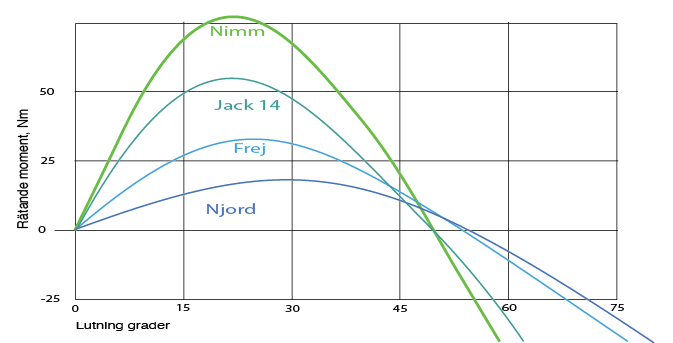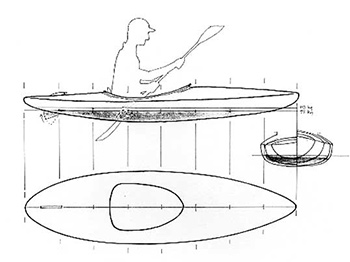Nimm
Latest updated Friday, January 3, 2025, 4 comments
Particulars | Background and history
Plans, Nimm - 130 EUR
Purchase
I have often toyed with the idea of a small and handy kayak for spontaneous trips in the surroundings, to offer to non-kayaking friends, or to fish from. I was not quite happy with the first attempts some fifteen years ago and it ended up in the maybe-some-day's file. But a related idea kept popping up in conversations on kayak meetings and in mail communications with builders: a short and simple "soap dish", but still a real no-compromise kayak. An engaged builder had a clear idea of what such a kayak would look like – so I cleared the desk and started. And now the drawings are finished and the first kayak is being built.
I call it Nimm – a convenient south Swedish dialect word for small, handy, and comfortable – because that is precisely what it is. It is not fast, but that is not a problem unless you challenge someone in a faster kayak. It is handy on land and on water, easy to use, and highly maneuverable. The initial stability is good enough for all kinds of fishing and it can safely be lent to non-kayaking visitors.
Nimm can be built as a light and simple kayak without any extras or outfitted with all the usual bells and whistles. An optional fixed skeg can improve the tracking at the expense of some maneuverability – an adjustable skeg will increase the performance potential. Hatches and bulkheads can be omitted – a short kayak is easily loaded from the large cockpit. But hatches and bulkheads are also a safety detail, making it possible to reenter in deep water without assistance.
Particulars

A flat bottom and substantial rocker mean a kayak that turns very easily, and at the same time lowers the center of gravity to increase initial stability. The ends are quite full to keep them out of water when surfing, with a rounded bottom profile for a smooth ride in steep seas. The deck and cockpit configuration is developed from Jack 14 (and Frej and Njord), but higher to offer more room for legs, feet, and gear, at the expense of some kayak control and ease of rolling.
| Length¹ |
285/272 cm (overall/WL) |
| Beam |
72/71 cm (overall/WL) |
| Draft |
12 cm |
| Cockpit¹ |
86x52 cm |
| Height¹ |
34/25 cm (in front of/behind the cockpit) |
| Weight² |
12-14 kg |
| Displacement/volume⁶ |
120 kg/316 litre |
| Speed³ |
6.5/8.9 km/h |
| Prismatic coefficient |
0.56 |
| Wetted surface |
1.58 m² |
| Drag⁴ |
2.7/5.5 kp |
| Stability⁵ |
5/5 (initial/secondary stability) |
| Intended use |
Liten behändig kayak för sommarstugan eller båten, för fisketurer eller som utlåningskajak till besökare – i sjöar, åar, eller skärgårdar. |
* These dimensions can be adapted to suit personal needs or wishes.
** Depending on type of wood, equipment, care with epoxy usage, sanding etc. etc.
*** The speed numbers are based on mathematical standard formulas (175 lb paddler + 30 lb carco weight) and corrected from the kayaks actual performance om trials, on tours and in races.
⁴ Calculated resistance in 4 and 5 knots (at nominal load capacity).
⁵ Initial stability and secondary stability on a subjective scale, where 1 is very tippy and 5 is very stable.
⁶ Displacement is kayak + paddler + load. Count off the kayak weight to get the load capacity.

Stability
The curve shows the calculated stability with a static load, and therefore of limited use for a real paddler. The part of the curve near zero degrees indicates the initial (primary) stability – the steeper the curve, the more stable. The part of the curve left of the peak indicates end (secondary) stability – the higher and wider, the safer you feel edging the kayak. The position of the peak shows also how much the kayak can be leaned without tipping over. The part of the curve to the right of the peak with rapidly decreasing righting moment is almost impossible to take advantage of. The other curves show Jack 14, Frej and Njord, which are based on the same hull idea.
Plans
To build the Nimm you will need approx 200 meters of wood strips (20x5 mm) including a margin for waste and one or two mistakes, 9 meters of fiberglass cloth (~160 gr/m2 on 100 cm width). The amount of epoxy is difficult to indicate since it depends on how it is used, but 5 kg may be reasonable. The figures are for the kayak as designed – if the dimensions are changed, you have to recalculate.
The kayak is in general easy to build, but short and wide kayaks are always trickier than long and narrow due to strips being bent tighter. Then, of course, any kayak project can be complicated if it involves decorative stripping or special outfitting. Note that the deck strips must be cut over the cockpit – trying to use full-length strips will make it impossible to get a nice deck line.
If you build in a small basement, you will need a window of at least 73z37 cm to lift the kayak out.

 The illustrated step-by-step building manual is in Swedish only, but it is available online in English: it covers all steps in detail and will guide first-time builders through the project.
The illustrated step-by-step building manual is in Swedish only, but it is available online in English: it covers all steps in detail and will guide first-time builders through the project.
Plans, Nimm - 130 EUR
Purchase
I have often toyed with the idea of a small and handy kayak for spontaneous trips in the surroundings, to offer to non-kayaking friends or to fish from. 15 years ago it even had a name. I called it "Nimm" – a convenient south Swedish dialect word for small, handy and comfortable – and it was a short soap dish of a kayak, without any real kayak qualities except for a certain versatility.
 The idea was "a semi-permanent roof box for the car, one that at any time could be used as a simple, easy-to-use kayak for surf, whitewater, or short trips. To be able to, at the spur-of-the-moment, explore a tempting waterway seen from the road or try out some stretch of whitewater when you happen to be in the neighborhood. To surf in breakers when the family plays on the beach or enjoys the summer sun. With an adjustable skeg, you have a simple play kayak for whitewater, that skeg down will be a touring kayak tracking reasonably well. A wooden locking cockpit cover keeps the content protected during transport".
The idea was "a semi-permanent roof box for the car, one that at any time could be used as a simple, easy-to-use kayak for surf, whitewater, or short trips. To be able to, at the spur-of-the-moment, explore a tempting waterway seen from the road or try out some stretch of whitewater when you happen to be in the neighborhood. To surf in breakers when the family plays on the beach or enjoys the summer sun. With an adjustable skeg, you have a simple play kayak for whitewater, that skeg down will be a touring kayak tracking reasonably well. A wooden locking cockpit cover keeps the content protected during transport".
But in the end, I was not quite happy with the first attempts and it ended up in the ever-growing archive for ideas that did not make it. The old Nimm would have been hard to build, boring to paddle, and lacking as a roof box. A "Mädchen-für-alles" is seldom what she promised to be. Instead of a compromise, I now focussed on a diminutive but "real" kayak, with a real kayak's potential.

